
Arctic Region Facts
Arctic Geography
The Arctic (pronounced ‘arktik‘ or ‘artik) is large region located in northern part of the globe. From Greek Arktikos, it means ‘near the bear, Arctic, northern’. It is geographically the opposite from the Antarctic. The Arctic region is often confused with the North Pole, which unlike the Arctic is only a point on the map. Arctic Circle is an area around North Pole which has a circle shape and is located on 66 °33 North Pole. Arctic circle line is where roughly the polar night begin. Generally speaking, Arctic region is considered the area within the boundaries of Arctic Circle.
Countries that are part of Arctic region are: Russia, Canada, United States, Denmark (Greenland), Norway, Finland, Sweden, Iceland. All countries are actively disputing waters and resources in what used to be remote and covered with ice region.
By far the largest water body in the Arctic is Arctic Ocean. Below is a complete list:
| Baffin Sea | Chukchi Sea | Hudson Bay |
| Baffin Bay | David Strait | Kara Sea |
| Beaufort Sea | Denmark Strait | Laptev Sea |
| Barents Sea | East Siberian Sea | Nares Strait |
| Bering Sea | Greenland Sea | Norwegian Sea |
| Bering Strait |
Arctic People
The Sami – the ancestors of the people who inhabit today’s northern FinnoScandia. The Sami left various monuments and artifacts believed to be created as early as 2,000 B.C.
The Chukchi – reside in Russian Far East, in a region called Chukotka Autonomous Okrug. The current population does not exceed 15,000. Due to harsh repression in Soviet times and economic collapse in 1990s, many Chukchi people were forced to adopt to urban lifestyle and abandon their native villages. Those that are still residing in villages, are often subject to heavy humanitarian aid which is their main source for food and drugs.
|
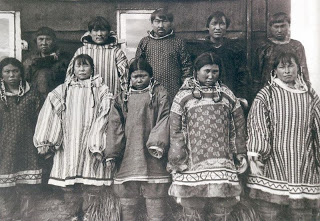 |
The Inupiat – populate primarily Alaska and Yukon. The locals are heavily dependent on fishing and hunting and even distance relatives of hunters are entities to a portion of the animals killed in the hunt.
Other Arctic people are: Evenks, Khanty, Koryaks, Nenets, Yukaghir and Yupik.
 Arctic Wild Life
Arctic Wild Life
Herbivores on the tundra include the Arctic hare, lemming, musk ox, and caribou. They are preyed on by the Arctic fox and wolf. The polar bear is also a predator, though it prefers to hunt for marine life from the ice. There are also many birds and marine species endemic to the colder regions. Other land animals include: wolverines, ermines, and arctic ground squirrels. Marine mammals include seals, walrus, and several species of cetacean—baleen whales and also narwhals, killer whales and belugas.
Polar Bear Populations
Polar bear population continues to shrink, according to many studies conducted in the last decate. Also, less ice, typically means less ground and food. There is only so much distance these powerful and heavy polar animals can swim. Over the past 3 decades, the climate change and the warming of the air and water temperatures in the Arctic region have caused severe ice melting, forcing many animals to change migration patterns and adopt to the new landscape with less or, at times, no ice.
Arctic Temperatures
Arctic temperatures are currently the highest on record and many believe are the highest in 2000 years.
Over the last 7,000 years, the timing of Earth’s closest pass by the sun has shifted from September to January. This has gradually reduced the intensity of sunlight reaching the Arctic in the Northern Hemisphere’s summertime, when Earth is farther from the sun (the main driver of summer temperatures is the fact that the hemisphere is tilted toward the sun during these months, while it is tilted away from the sun during winter).
The team’s temperature analysis shows that summer temperatures in the Arctic, in step with the reduced energy from the sun, cooled at an average rate of about .35 degrees Fahrenheit (0.2 degrees Celsius) per thousand years. The temperatures eventually bottomed out during the “Little Ice Age,” a period of widespread cooling that lasted roughly from the 16th to the mid-19th centuries.
Arctic Disputes
With melting ice and natural resources becoming accessible countries in the Arctic region are competing for them. Norway, Denmark (Greenland), Iceland, Canada and the United States are engaged in multiple territorial disputes, some negotiated in the United Nations, some during Arctic Summits, others on one-on-one basis.
The biggest Arctic dispute is happening around United Nations’ Law of the Seas submission deadline of 2013 by which nations must provide a scientific proof where their shelf ends. Based on the boundary of the shelf, countries may extend their boundaries by as much as 200 miles from that line. Arctic is a particularly active place for claims submission considering recent discoveries of natural gas and oil in the region.
Northwest Passage: United States – Canada Dispute Northwest Passage is a water route connecting Atlantic Ocean and Pacific Ocean and lies between hundreds of Canadian islands. Canada claims that the route is within Canada and therefore only Canadian ships are entitles to use the route. Other countries, and especially the United States refuse to recognize Canadian claim and believe the passage should be open to all countries.
|
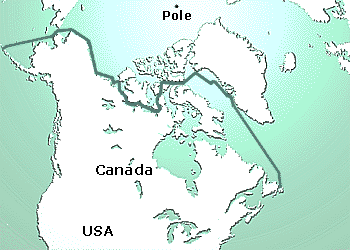 |
Barents Sea: Russia – Norway Dispute Russia and Norway are battling out who is the true master of the Barents Sea that is filled with natural gas and oil right in the middle of the sea. With Norway having a formal control over an international territory of Svalbard (Spitsbergen Treaty, 1920), Norway is claiming vast areas of the Barents Sea stretching far east of Norwegian waters . Russia would like to draw a slightly different line so that more natural resources fall on the Russian side. Norway is a member of NATO alliance and has not been willing to give up any of its claims making compromise less likely. Both countries declined to agree to each other’s submissions to extend sea borders in the Barents Sea area. Currently, countries are negotiating on the level of foreign ministers prior to re-submission of the claims to UN. |
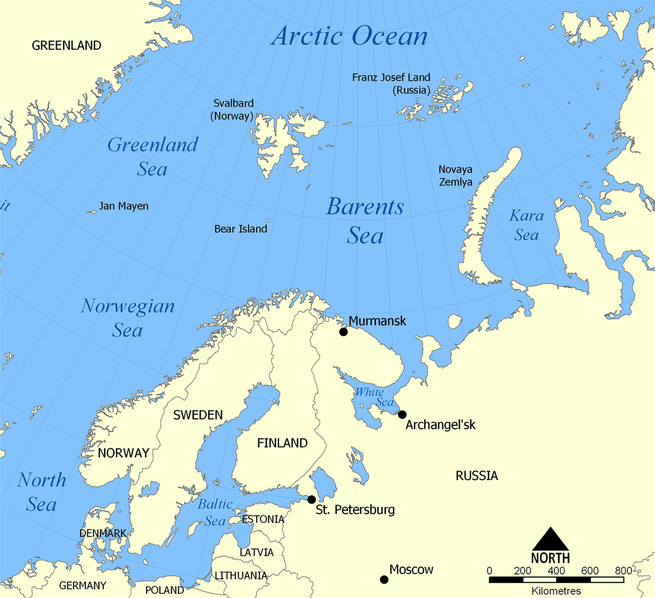 |
Bering Sea: Russia – United States Dispute Since the purchase of Alaska from Russia in 1863, the United States and Russia have been trying to finalize marine boundaries. Most recent attempt was made in 1990 and became known as Baker-Shevarnadze treaty. With the fall of Soviet Union, Russian parliament has refused to ratify the treaty and Russian diplomats from time to time attempt to re-negotiate some of the agreements made in 1990. Russian argument is largely based on the fact that Shevarnadze was not authorized and was not acting on behalf of the country’s interests. Accidentally, in 1993 Shevarnadze came to power after a bloody civil war in Georgia to become countries second president. Georgia remains a close ally of the United States to this day. United States has been refusing to re-negotiate the treaty and believes that 1990 agreement is final and cannot be changed.
|
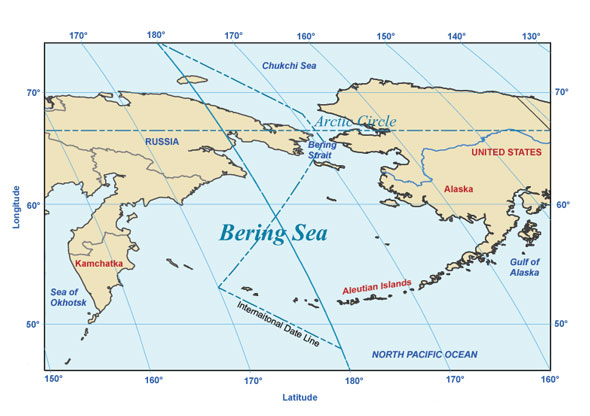 |
Hans Island: Denmark – Canada Dispute Denmark and Canada are fighting over Hans Island for over 60 years now. It is currently under Danish control but Canadian have repeatedly attempted to establish foothold there and even made several landings with flag planting. |
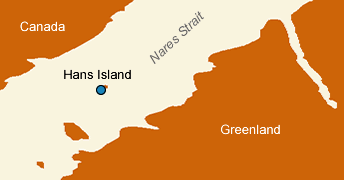 |
Lomonosov Ridge: Russia – Canada – Denmark Dispute
Russia, Denmark and Canada all are claiming that Lomonosov ridge is a continuation of their continental shelf, therefore allowing them to proclaim sovereignty over it and additional 200 miles adjacent to it.
Denmark is using Greenland to proclaim that Lomonosov ridge is a natural continuation of the world’s largest island. Canada has a slightly different point of view, stating that the massive ridge is part of North American continent. Russia, arguably spending the most time and money to conduct scientific research on the subject had launched several expeditions, including to the bottom of the the Arctic Ocean right under the North Pole. Russia believes that Lomonosov Ridge is a continuation of Siberia (Northern Asia).